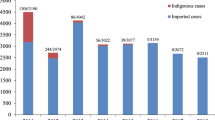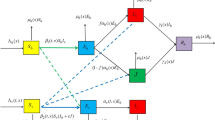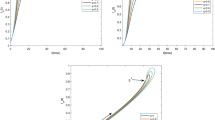Abstract
In this manuscript, we formulate a malaria model with nonlinear incidence and recovery rates to study the impact of the health system’s available resources on disease spread and control. A detailed analysis of the model is provided. It is determined that when the basic reproduction number, \({\mathcal {R}}_0\), is less than unity, the disease may or may not die out due to nonlinear recovery rate. In addition, it is asserted that if the recovery rate is constant, disease eradication is possible for \({\mathcal {R}}_0<1\). The global stability of the unique endemic equilibrium point is established using geometric approach. The model system is also examined for Hopf bifurcation, and it is established that certain conditions on the transmission rate from vector to human lead to the emergence of periodic oscillations in the model system. Keeping in mind the nonlinear nature of the hypothesized model, we develop a non-standard finite difference (NSFD) scheme by discretizing the system. It is proven that conservation law and the positivity of the solutions are maintained by the proposed NSFD method for all finite step sizes. Furthermore, the convergence and error bounds of the developed schemes are also explored. To validate the analytical results, numerical simulations using our computational scheme are presented and these results are compared to two well-known standard numerical techniques, viz. the fourth-order Runge–Kutta (RK4) method and the forward Euler method. It is found that conventional numerical schemes fail to accurately capture the dynamics of the continuous model for certain step sizes, resulting in unstable and negative numerical solutions. In contrast, the developed NSFD scheme successfully retains the fundamental mathematical characteristics of the continuous model. It is worth mentioning that the NSFD schemes also capture the backward bifurcation phenomenon. In addition, numerical simulations show that Hopf bifurcation occurs due to transmission rate.



















Similar content being viewed by others
Data availability
The authors declare that there are no data associated with this manuscript.
References
A. Abdelrazec, J. Bélair, C. Shan, H. Zhu, Modeling the spread and control of dengue with limited public health resources. Math. Biosci. 271, 136–145 (2016)
S. Acharya, B. Mondal, R.K. Upadhyay, P. Das, Exploring noise-induced dynamics and optimal control strategy of iSIR cholera transmission model. Nonlinear Dyn. 112, 1–25 (2024)
S. Acharya, R.K. Upadhyay, B. Mondal, Impact of Allee Effect on the Spatio-temporal behavior of a diffusive epidemic model in heterogenous environment. Int. J. Bifurc. Chaos 33(16), 2350194 (2023)
P. Saha, B. Mondal, U. Ghosh, Dynamical behaviors of an epidemic model with partial immunity having nonlinear incidence and saturated treatment in deterministic and stochastic environments. Chaos, Solitons & Fractals 174, 113775 (2023)
P. Saha, B. Mondal, U. Ghosh, Global dynamics and optimal control of a two-strain epidemic model with non-monotone incidence and saturated treatment. Iran. J. Sci. 1–17 (2023)
A.K. Srivastav, M. Ghosh, Modeling the transmission dynamics of malaria with saturated treatment: a case study of India. J. Appl. Math. Comput. 67(1), 519–540 (2021)
A.F. Cowman, J. Healer, D. Marapana, K. Marsh, Malaria: biology and disease. Cell 167(3), 610–624 (2016)
C.N. Ngonghala, S.Y. Del Valle, R. Zhao, J. Mohammed-Awel, Quantifying the impact of decay in bed-net efficacy on malaria transmission. J. Theor. Biol. 363, 247–261 (2014)
Centers for Disease Control and Prevention- Malaria:. https://www.cdc.gov/parasites/malaria/index.html
R. Ross, The Prevention of Malaria (John Murray, 1911)
F. Agusto, S. Lenhart, Optimal control of the spread of malaria superinfectivity. J. Biol. Syst. 21(04), 1340002 (2013)
F.B. Agusto, S.Y. Del Valle, K.W. Blayneh, C.N. Ngonghala, M.J. Goncalves, N. Li, R. Zhao, H. Gong, The impact of bed-net use on malaria prevalence. J. Theor. Biol. 320, 58–65 (2013)
B. Buonomo, C. Vargas-De-León, Stability and bifurcation analysis of a vector-bias model of malaria transmission. Math. Biosci. 242(1), 59–67 (2013)
X. Feng, S. Ruan, Z. Teng, K. Wang, Stability and backward bifurcation in a malaria transmission model with applications to the control of malaria in China. Math. Biosci. 266, 52–64 (2015)
K.O. Okosun, R. Ouifki, N. Marcus, Optimal control analysis of a malaria disease transmission model that includes treatment and vaccination with waning immunity. Biosystems 106(2–3), 136–145 (2011)
H. Tasman et al., An optimal control strategy to reduce the spread of malaria resistance. Math. Biosci. 262, 73–79 (2015)
J. Wang, X.-Z. Li, S. Bhattacharya, The backward bifurcation of a model for malaria infection. Int. J. Biomath. 11(02), 1850018 (2018)
L.-M. Cai, X.-Z. Li, Global analysis of a vector-host epidemic model with nonlinear incidences. Appl. Math. Comput. 217(7), 3531–3541 (2010)
P. Roop-O, W. Chinviriyasit, S. Chinviriyasit, The effect of incidence function in backward bifurcation for malaria model with temporary immunity. Math. Biosci. 265, 47–64 (2015)
S. Ullah, M.F. Khan, S.A.A. Shah, M. Farooq, M.A. Khan, M.B. Mamat, Optimal control analysis of vector-host model with saturated treatment. Eur. Phys. J. Plus 135(10), 1–25 (2020)
C. Shan, H. Zhu, Bifurcations and complex dynamics of an SIR model with the impact of the number of hospital beds. J. Differ. Equ. 257(5), 1662–1688 (2014)
F.S. Alshammari, M.A. Khan, Dynamic behaviors of a modified SIR model with nonlinear incidence and recovery rates. Alex. Eng. J. 60(3), 2997–3005 (2021)
J.K.K. Asamoah, F. Nyabadza, Z. Jin, E. Bonyah, M.A. Khan, M.Y. Li, T. Hayat, Backward bifurcation and sensitivity analysis for bacterial meningitis transmission dynamics with a nonlinear recovery rate. Chaos, Solitons & Fractals 140, 110237 (2020)
G.-H. Li, Y.-X. Zhang, Dynamic behaviors of a modified SIR model in epidemic diseases using nonlinear incidence and recovery rates. PLoS ONE 12(4), e0175789 (2017)
F. Nyabadza, J.M. Aduamah, J. Mushanyu, Modelling cholera transmission dynamics in the presence of limited resources. BMC Res. Not. 12(1), 1–8 (2019)
P. Saha, U. Ghosh, Global dynamics and control strategies of an epidemic model having logistic growth, non-monotone incidence with the impact of limited hospital beds. Nonlinear Dyn. 105(1), 971–996 (2021)
H. Zhao, L. Wang, S. Oliva, H. Zhu, Modeling and dynamics analysis of Zika transmission with limited medical resources. Bull. Math. Biol. 82(8), 1–50 (2020)
X.-W. Jiang, X.-S. Zhan, Z.-H. Guan, X.-H. Zhang, Yu. Li, Neimark-Sacker bifurcation analysis on a numerical discretization of Gause-type predator-prey model with delay. J. Franklin Inst. 352(1), 1–15 (2015)
M. Peng, Bifurcation and chaotic behavior in the Euler method for a Kaplan-Yorke prototype delay model. Chaos, Solitons & Fractals 20(3), 489–496 (2004)
R.E. Mickens, Difference equation models of differential equations. Math. Comput. Model. 11, 528–530 (1988)
R.E. Mickens, Nonstandard Finite Difference Models of Differential Equations (World Scientific, 1994)
R.E. Mickens, Numerical integration of population models satisfying conservation laws: NSFD methods. J. Biol. Dyn. 1(4), 427–436 (2007)
R.E. Mickens, P.M. Jordan, A positivity-preserving nonstandard finite difference scheme for the damped wave equation. Numer. Methods Partial Differ. Equ. Int. J. 20(5), 639–649 (2004)
Q. Cui, X. Jiabo, Q. Zhang, K. Wang, An NSFD scheme for SIR epidemic models of childhood diseases with constant vaccination strategy. Adv. Differ. Equ. 2014(1), 1–15 (2014)
A.M. Elaiw, M.A. Alshaikh, Stability preserving NSFD scheme for a general virus dynamics model with antibody and cell-mediated responses. Chaos, Solitons & Fractals 138, 109862 (2020)
S.M. Garba, A.B. Gumel, J.M.S. Lubuma, Dynamically-consistent non-standard finite difference method for an epidemic model. Math. Comput. Model. 53(1–2), 131–150 (2011)
T.S. Shaikh, N. Fayyaz, N. Ahmed, N. Shahid, M. Rafiq, I. Khan, K.S. Nisar, Numerical study for epidemic model of hepatitis-B virus. Eur. Phys. J. Plus 136(4), 1–22 (2021)
A. Suryanto, I. Darti, On the nonstandard numerical discretization of SIR epidemic model with a saturated incidence rate and vaccination. AIMS Math. 6, 141–155 (2021)
I. Darti, A. Suryanto, Stability preserving non-standard finite difference scheme for a harvesting Leslie-Gower predator-prey model. J. Differ. Equ. Appl. 21(6), 528–534 (2015)
A.K. Misra, N. Jha, R. Patel, Modeling the effects of insects and insecticides with external efforts on agricultural crops. Differ. Equ. Dyn. Syst. 1–18 (2020)
K. Mokni, M. Ch-Chaoui, B. Mondal, U. Ghosh, Rich dynamics of a discrete two dimensional predator–prey model using the NSFD scheme. Math. Comput. Simul. (2023)
P. Saha, N. Bairagi, M. Biswas, On the dynamics of a discrete predator–prey model. Trends Biomath. Model. Optim. Comput. Probl. 219–232 (2018)
Q.A. Dang, M.T. Hoang, Complete global stability of a metapopulation model and its dynamically consistent discrete models. Qual. Theory Dyn. Syst. 18(2), 461–475 (2019)
M.M. Khalsaraei, A. Shokri, H. Ramos, S. Heydari, A positive and elementary stable nonstandard explicit scheme for a mathematical model of the influenza disease. Math. Compute. Simul. 182, 397–410 (2021)
S. Liao, W. Yang, A nonstandard finite difference method applied to a mathematical cholera model. Bull. Korean Math. Soc. 54(6), 1893–1912 (2017)
E.M. Adamu, K.C. Patidar, A. Ramanantoanina, An unconditionally stable nonstandard finite difference method to solve a mathematical model describing Visceral Leishmaniasis. Math. Comput. Simul. 187, 171–190 (2021)
M.T. Hoang, Dynamically consistent nonstandard finite difference schemes for a virus-patch dynamic model. J. Appl. Math. Comput. 68(5), 3397–3423 (2022)
M.T. Hoang, Reliable approximations for a hepatitis B virus model by nonstandard numerical schemes. Math. Comput. Simul. 193, 32–56 (2022)
M.T. Hoang, Dynamical analysis of a generalized hepatitis B epidemic model and its dynamically consistent discrete model. Math. Comput. Simul. 205, 291–314 (2023)
A.K. Misra, N. Jha, R. Patel, Modeling the effects of insects and insecticides on agricultural crops with NSFD method. J. Appl. Math. Comput. 63, 197–215 (2020)
J.C. Koella, On the use of mathematical models of malaria transmission. Acta Trop. 49(1), 1–25 (1991)
R.M. Anderson, The persistence of direct life cycle infectious diseases within populations of hosts. Lect. Math. Life Sci. 12, 1–67 (1979)
P. Van den Driessche, J. Watmough, Reproduction numbers and sub-threshold endemic equilibria for compartmental models of disease transmission. Math. Biosci. 180(1–2), 29–48 (2002)
C.C. Chavez, Z. Feng, W. Huang, On the computation of R0 and its role on global stability. Math. Approach. Emerg. Re-emerg. Infect. Dis. Introduction 125, 31–65 (2002)
C. Castillo-Chavez, B. Song, Dynamical models of tuberculosis and their applications. Math. Biosci. Eng. 1(2), 361 (2004)
H.I. Freedman, S. Ruan, M. Tang, Uniform persistence and flows near a closed positively invariant set. J. Dyn. Differ. Equ. 6(4), 583–600 (1994)
M.Y. Li, J.S. Muldowney, A geometric approach to global-stability problems. SIAM J. Math. Anal. 27(4), 1070–1083 (1996)
W.-M. Liu, Criterion of Hopf bifurcations without using eigenvalues. J. Math. Anal. Appl. 182(1), 250–256 (1994)
R.E. Mickens, Exact solutions to a finite-difference model of a nonlinear reaction-advection equation: Implications for numerical analysis. Numer. Methods Partial Differ. Equ. 5(4), 313–325 (1989)
R.E. Mickens, Applications of Nonstandard Finite Difference Schemes (World Scientific, 2000)
R.E. Mickens, Dynamic consistency: a fundamental principle for constructing nonstandard finite difference schemes for differential equations. J. Differ. Equ. Appl. 11(7), 645–653 (2005)
L. Jódar, R.J. Villanueva, A.J. Arenas, G.C. González, Nonstandard numerical methods for a mathematical model for influenza disease. Math. Comput. Simul. 79(3), 622–633 (2008)
L.J.S. Allen, An Introduction to Mathematical Biology (Pearson/Prentice Hall, Upper Saddle River, 2007)
U.M. Ascher, L.R. Petzold, Computer Methods for Ordinary Differential Equations and Differential-Algebraic Equations, vol. 61 (SIAM, 1998)
B. Buonomo, Analysis of a malaria model with mosquito host choice and bed-net control. Int. J. Biomath. 8(06), 1550077 (2015)
S.M. Garba, A.B. Gumel, M.R.A. Bakar, Backward bifurcations in dengue transmission dynamics. Math. Biosci. 215(1), 11–25 (2008)
L. Cai, S. Guo, X.Z. Li, M. Ghosh, Global dynamics of a dengue epidemic mathematical model. Chaos, Solitons & Fractals 42(4), 2297–2304 (2009)
A. Khatua, T.K. Kar, Dynamical behavior and control strategy of a dengue epidemic model. Eur. Phys. J. Plus 135, 1–22 (2020)
M. Ozair, A.A. Lashari, I.H. Jung, K.O. Okosun, et al., Stability analysis and optimal control of a vector-borne disease with nonlinear incidence. Discrete Dyn. Nat. Soc. 2012 (2012)
N. Bairagi, M. Biswas, A predator-prey model with Beddington-DeAngelis functional response: a non-standard finite-difference method. J. Differ. Equ. Appl. 22(4), 581–593 (2016)
M. Biswas, N. Bairagi, On the dynamic consistency of a two-species competitive discrete system with toxicity: Local and global analysis. J. Comput. Appl. Math. 363, 145–155 (2020)
G. González-Parra, A.J. Arenas, B.M. Chen-Charpentier, Combination of nonstandard schemes and Richardson’s extrapolation to improve the numerical solution of population models. Math. Comput. Model. 52(7–8), 1030–1036 (2010)
Acknowledgements
The authors are thankful to the anonymous reviewers and the handling editor for providing valuable suggestions and comments that have greatly enhanced the quality of this paper.
Author information
Authors and Affiliations
Contributions
TS was involved in the conceptualization, formal analysis, validation, visualization, and writing—original draft. PKS contributed to the conceptualization, supervision, visualization, and writing—review and editing. PB assisted in the conceptualization, supervision, formal analysis, and writing—original draft.
Corresponding author
Ethics declarations
Conflict of interest
The authors declare that they have no conflict of interest.
Appendices
Appendix 1
Appendix 2
Rights and permissions
Springer Nature or its licensor (e.g. a society or other partner) holds exclusive rights to this article under a publishing agreement with the author(s) or other rightsholder(s); author self-archiving of the accepted manuscript version of this article is solely governed by the terms of such publishing agreement and applicable law.
About this article
Cite this article
Sarkar, T., Srivastava, P.K. & Biswas, P. Application of the NSFD method in a Malaria model with nonlinear incidence and recovery rates. Eur. Phys. J. Plus 139, 257 (2024). https://doi.org/10.1140/epjp/s13360-024-05045-x
Received:
Accepted:
Published:
DOI: https://doi.org/10.1140/epjp/s13360-024-05045-x




